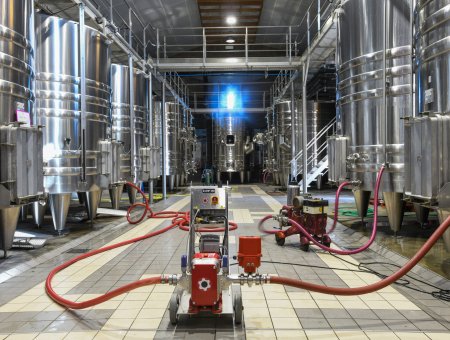CO2 detectors
Faced with this constant threat of carbon dioxide (CO2) to cellar workers during vinification, traditional practices such as the candle test are proving dangerously ineffective, as the flame can continue to burn despite already lethal levels of CO₂. Only a rigorous preventive approach, combining appropriate ventilation, reliable detection and staff training, can effectively make winegrowing operations safe.

Introduction
Carbondioxide (CO₂), an odourless, colourless gas that is heavier than air, is a natural by-product of alcoholic fermentation. In wine cellars, its presence can reach dangerous, even lethal concentrations, without any visible or olfactory warning signs. Hence the urgent need for a balance between technical prevention and human vigilance.The invisible danger of CO₂ in cellars
A silent threat
According to the MSA, CO₂ is an "invisible danger" likely to cause avoidable poisoning on wine farmsA tragic case in Chinonais at the end of 2023 highlighted the vital issue of prevention against CO₂ poisoning, particularly during the winemaking and maturing phase |
Phases at risk
Critical moments include fermentation, devatting and tank cleaning. CO₂ accumulates at the bottom of vats and in confined areas, where even a vented vat can become dangerous again if lees are still fermentingThe candle test: a dangerous illusion
A still widespread practice, the candle (or lighter) test, is formally not recommended: the flame remains visible well above lethal CO₂ thresholds, and only reflects the absence of oxygen, not the safety of breathable air. An educational experiment has shown that a candle can continue to burn when the detectors are already measuring dangerous levels, confirming the ineffectiveness of this method. |Preventive measures recommended by the MSA
Fundamental principles
Prevention organisations insist on three pillars: capture at source, suitable ventilation and reliable detection. These measures are essential to reduce exposure to CO₂.Design and ventilation
Ideally integrated into the design of the winery, prevention should aim to limit gas stagnation zones and facilitate efficient air renewal. Mechanical ventilation - blowing in fresh air or forced extraction - is recommended, especially in confined spaces.Reliable detection & awareness
Accurate detection of CO₂ is essential: only specialised sensors can reliably measure CO₂ levels.Educational materials (brochures, posters), as well as awareness-raising workshops, have been deployed to involve winegrowers in prevention
Training & best practice
MSA health and safety officers encourage- Detection of the atmosphere inside a tank before any work is carried out;
- Safe organisation of work, with no single person in high-risk areas;
- Rapid cleaning and removal of fermentable lees (a prolonged source of CO₂);
- Clear emergency procedures, including prevention of rescue.
Key features of a suitable detector
The following types of equipment are recommended:General characteristics of detectors
- Measurement technology: infrared (or equivalent) detectors are preferred for their accuracy and long-term reliability.
- Safety functions: audible, visual and even vibrating alarms for immediate reaction when critical thresholds are exceeded.
Modes of use
- Portable models: to be used before entering a tank or confined space. They must be tested in ambient air to validate their calibration (at around 0.04% CO₂).
- Fixed models: designed for continuous monitoring of work areas or winery premises; they can be integrated into the ventilation system to trigger action if necessary.
Maintenance and reliability
- Eliminate drift: a measurement drift of just 20-30% can compromise safety.
- Regular calibration and verification: at least once a year, to ensure measurement reliability.
Summary of recommendations for winegrower
| Prevention | Recommended actions |
| Design of the winery |
|
| Capture and ventilation |
|
| CO2 detection |
|
| Work organisation and training |
|
| Equipment maintenance |
|












